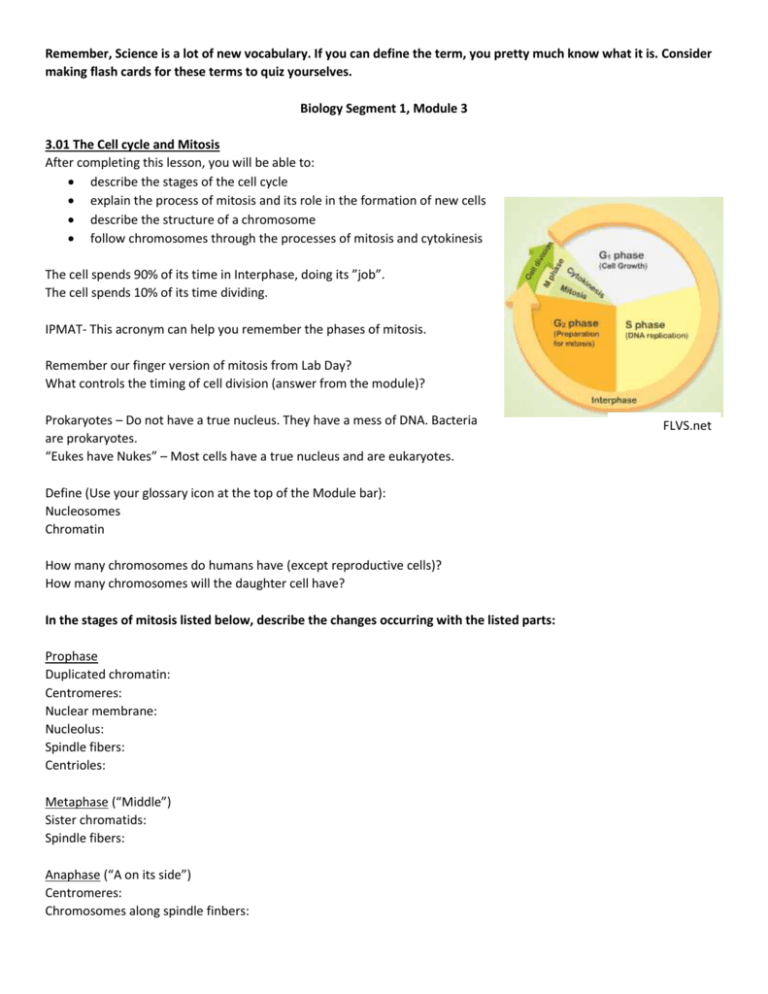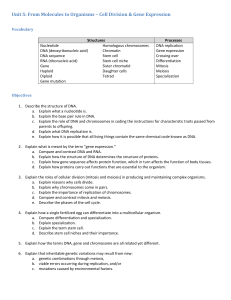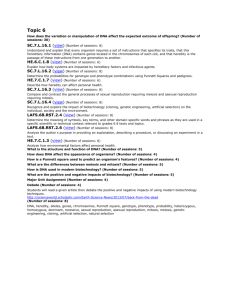Remember, Science is a lot of new vocabulary. If you can define the
advertisement

Remember, Science is a lot of new vocabulary. If you can define the term, you pretty much know what it is. Consider making flash cards for these terms to quiz yourselves. Biology Segment 1, Module 3 3.01 The Cell cycle and Mitosis After completing this lesson, you will be able to: describe the stages of the cell cycle explain the process of mitosis and its role in the formation of new cells describe the structure of a chromosome follow chromosomes through the processes of mitosis and cytokinesis The cell spends 90% of its time in Interphase, doing its ”job”. The cell spends 10% of its time dividing. IPMAT- This acronym can help you remember the phases of mitosis. Remember our finger version of mitosis from Lab Day? What controls the timing of cell division (answer from the module)? Prokaryotes – Do not have a true nucleus. They have a mess of DNA. Bacteria are prokaryotes. “Eukes have Nukes” – Most cells have a true nucleus and are eukaryotes. Define (Use your glossary icon at the top of the Module bar): Nucleosomes Chromatin How many chromosomes do humans have (except reproductive cells)? How many chromosomes will the daughter cell have? In the stages of mitosis listed below, describe the changes occurring with the listed parts: Prophase Duplicated chromatin: Centromeres: Nuclear membrane: Nucleolus: Spindle fibers: Centrioles: Metaphase (“Middle”) Sister chromatids: Spindle fibers: Anaphase (“A on its side”) Centromeres: Chromosomes along spindle finbers: FLVS.net Telophase Chromosomes: Nuclear membrane: Spindle fibers: Nucleolus: Define: Cytokinesis Cell plate Describe a difference of cytokinesis in animals and plants. How does cancer involve cell division? Define: Mutation List potential causes of cancer 1. miscopying of DNA from S phase 2. 3. 4. 5. 6. Cancer: Nova online link DNA mutation > cell replication > development of tumor > breakthrough epithelial tissue basement membrane (tumor is no longer contained) > blood vessels form to feed tumor > invasion and dispersal (metastasis) > tumors develop in other areas of the body. Define: Stem cells Differentiation Name the 3 types of stem cells 1. 2. 3. (Cord blood from the placenta can be harvested at birth and is rich in stem cells. Google cord blood banking if you’d like to know more). Name potential uses of stem cells 1. 2. 3. 4. 5. (many diseases) Lesson 3.02 Meiosis After completing this lesson, you will be able to: differentiate between body cells and gametes compare autosomes and sex chromosomes compare the two cycles of division in meiosis describe how haploid cells develop into gametes explain how crossing over during meiosis increases genetic diversity compare mitosis and meiosis “OH MY-OSIS! It’s reproduction!” Define: Asexual reproduction Name 3 types of asexual reproduction and an example of an organism that reproduces this way: 1. 2. 3. Name 2 advantages of this method of reproduction 1. 2. Name a disadvantage 1. Define Sexual reproduction Alleles Comparison Table Type of reproduction Number of parents Genetic Diversity Characteristics Asexual reproduction Define: Haploid (N) Diploid (2N) Homologous Gametes Fertilization Zygote How many chromosomes do human cells have (total)? How many pairs or sets do human cells have? Sexual reproduction Define: Sex chromosomes Autosomes Genetic diversity Please watch “Crash Course video on Meiosis”. It is hysterical, and so very helpful! Stages of Meiosis: Interphase Prophase I Metaphase I * 4 chromosomes line up in 2 sets of 2, *crossing over, * Chromosome arrangement Anaphase I Telophase I Cytokinesis 2 cells Interphase II * This time, DNA does not replicate Prophase II Metaphase II * Chromosome arrangement, AKA Law of Independent Assortment – next lesson Anaphase II Telophase II Cytokinesis 4 cells How many combinations in chromosomes are possible in human fertilization (assuming 1 crossover)? How many crossovers typically occur during one fertilization event? Let’s compare mitosis and meiosis. (FLVS) Event Mitosis Meiosis DNA replication, forming sister chromatids. Occurs during interphase before nuclear division begins. Occurs during interphase before nuclear division begins. Number of division cycles One, consisting of prophase, metaphase, anaphase, telophase, and cytokinesis. Two, each consisting of consisting of prophase, metaphase, anaphase, telophase, and cytokinesis. Total number of daughter cells Two diploid cells, genetically identical to the parent cell. Four haploid cells, containing half as many chromosomes as the original parent cell. Importance Production of diploid body cells for growth and repair. Production of haploid gamete cells for sexual reproduction. Lesson 3.03 Mendel After completing this lesson, you will be able to: describe the patterns of inheritance that Mendel’s data revealed summarize Mendel's law of segregation explain how there can be many variations of one gene Define: Polydactyl Genetics Cross pollination Hybrids Hybridization Monohybrid cross P generation F 1 generation F 2 generation Dominant trait (Capital letter) Recessive trait (Lower case letter) Principle of Dominance Law of Segregation What were the 4 conclusions Mendel about heredity and inheritance. 1. 2. 3. 4. 3.04 Heredity Patterns After completing this lesson, you will be able to: describe how genes influence the development of traits describe patterns of inheritance describe monohybrid and dihybrid crosses explain how heredity can be illustrated mathematically Define: Homozygous Heterozygous Genotype Phenotype Punnett Square Test Cross Monohybrid cross (1 trait, or alleles) Dihybrid cross (2 traits, or alleles) We will cover this at Lab Day FLVS.net Important things to keep in mind: In the case of a dihybrid cross with 16 total squares, each box represents a 1 in 16 chance, or 6.25%. When more than one box contains the same genotype or phenotype, their percentages can be added together to determine the probability of an offspring having that genotype of phenotype. Genotype: 1 RRYY: 2 RRYy: 2 RrYY: 4RrYy: 1 RRyy: 2 Rryy: 1 rrYY: 2 rrYy: 1 rryy or: 6.25% RRYY: 12.5% RRYy: 12.5% RrYY: 25% RrYy: 6.25% RRyy: 12.5% Rryy: 6.25% rrYY: 12.5% rrYy: 6.25% rryy Phenotype: 9 round yellow: 3 round green: 3 wrinkled yellow: 1 wrinkled green or: 56.25% round yellow: 18.75% round green: 18.75% wrinkled yellow: 6.25% wrinkled green The majority of genes have more than 2 _____________________________. Many important traits are controlled by more than one ______________________________. What are the “sex” genes (they are letters) ____ ____ = female, ____ ____ = male Multiple alleles, i.e. blood type. Type A, Type B, Type O IA and IB are co-dominant. iO is recessive. Polygenetic traits: Controlled by more than one gene, i.e. tongue rolling, height Pedigree Chart: A C B Square = Circle = Shaded = Line A = Line B = Line C = Lesson 3.05 DNA Replication After completing this lesson, you will be able to: describe the structure of DNA summarize the process of DNA replication describe the relationship between RNA and DNA explain the processes of transcription and translation Name the accomplishments: 1865, Mendel 1903 Sutton 1911 Morgan 1928 Griffith 1944 Avery, Macleod, McCarty 1949 Chargraff 1952 Franklin 1953 Watson and Crick 2003 Venter and Collins Define: Nucleotides Nitrogenous Base Hydrogen bonding Base pairing A-T, C-G Complimentary Replication DNA replication: 1. Break H bonds, DNA polymerase joins nucleotides on complimentary strands, DNA polymerase proofreads. tRNA-O The overall story: rRNA DNA Nucleus mRNA oooooooooooooooooooooooooo o Ribosome Protein (amino acid chain) --------------------------------------- Cytoplasm ----------------------------------------------- --------------- transcription ---------------- --------------translation--------------------------- “Both DNA and RNA are nucleic acids made up of nucleotides, but there are three important differences between DNA and RNA: 1. RNA is single-stranded, and DNA is double-stranded. 2. The sugar in RNA’s nucleotides is ribose instead of deoxyribose. 3. RNA contains the nitrogenous base uracil instead of the thymine in DNA.” FLVS Define: Messenger RNA Ribosomal RNA Transfer RNA DNA replication (like in mitosis) DNA helicase (unzips the DNA helix) DNA polymerase Transcription RNA polymerase Translation RNA codon (also start codon, stop codon) Transfer RNA + anticodon DNA- ATGC’s RNA- AUGC’s How many amino acids are there is all organisms? Lesson 3.06 Introduction to Mutations Objectives: Distinguish between different types of mutations Explain why mutations may or may not affect phenotype Identify internal and external factors that regulate cell division Explain cancer in terms of the cell cycle Define: Mutation Deletion Duplication Inversion (a new one for me) Translocation (actually responsible for acute leukemia) Point mutations Base pair substitution Insertion Deletion Frame shift Germ line mutation- a mutation that offspring inherit. Gene expression Mutagens Nondisjunction Polyploidy – Multiple copies of chromosomes in the nucleus. Normal is 2N. Polyploidy can have 4N Cancer- “We now know that cancers can be caused by mutations in the genes that regulate growth and division in a cell. Viral infections, exposure to smoking and chewing tobacco, radiation, and other defective genes can all be the source of these mutations. Many cancer cells have a defect in a gene called p53, which is responsible for delaying the cell cycle until all chromosomes are replicated. Mutations or damage to this gene make cells unable to respond to the signals that normally control their growth and division.” FLVS 3.07 Biotechnology After completing this lesson, you will be able to: explain how technology helps to compare and study genes and proteins describe what a DNA fingerprint represents describe the impact that DNA fingerprinting has on an individual and society describe the impact biotechnology makes on individuals, society, and the environment Steps of Biotech: 1. Sequence the gene you want to insert (Target gene) 2. Cut the Target gene DNA before and after the gene with a restriction enzyme (it makes sticky ends) 3. Cut the receiving DNA with a the same restriction enzyme (it makes the same sticky ends) 4. DNA pieces combine with the enzyme DNA ligase 5. Now you have a recombinant gene Page 2 of 3 shows a diagram of a DNA fragments on a gel being probed. You would do this if you were looking for a specific piece of DNA from an unknown sample. (For example, I would like to know if my patient has the BRAC 1 or BRAC 2 gene. I will probe her DNA for it). Define Genetic engineers DNA ligase Recombinant DNA Transgenic Cloning DNA fingerprinting Gel electrophoresis Forensic science Which moves faster through a gel, a short piece or long piece of DNA? Which charge does DNA move to, positive or negative? 3.08 Health and Genetics After completing this lesson, you will be able to: explain how heredity and family history impact health explain how individual and public health are affected by environmental and genetic factors Genetic factors – alleles passed from parents to child Infectious disease – from pathogens (virus, bacteria, protists, fungi, parasites) Names some ways that humans can be exposed to infectious pathogens 1. 2. 3. 4. Name the different drug groups (from the table)









